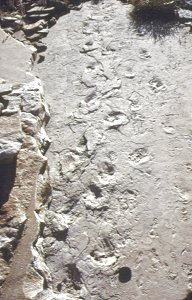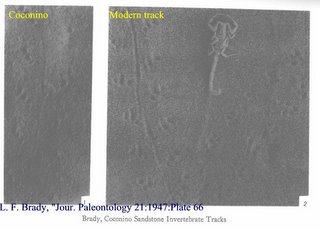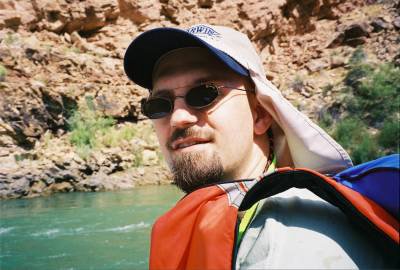Creationism and the Coconino Footprints
 The Coconino Sandstone is a layer of sediment roughly 1/5th of the way down into the Grand Canyon's chasm. It is unique among the layers because of its criss-crossed pattern, which indicates that it was layed down in alternating currents, probably by wind. Indeed, the cross-bedding strongly suggests sand dunes and a desert environment. There are even fossilized footprints where quadraped reptiles once walked across the sand. The upper-left photo shows some of these.
The Coconino Sandstone is a layer of sediment roughly 1/5th of the way down into the Grand Canyon's chasm. It is unique among the layers because of its criss-crossed pattern, which indicates that it was layed down in alternating currents, probably by wind. Indeed, the cross-bedding strongly suggests sand dunes and a desert environment. There are even fossilized footprints where quadraped reptiles once walked across the sand. The upper-left photo shows some of these.
Naturally, creationists don't like this at all. They contend that the Grand Canyon's layers were put there, all of them, by the massive floodwaters during the time of Noah -- or at least, all the layers above the Great Unconformity. So finding evidence of a desert right in one of the upper-middle layers trumps their argument. Did the floodwaters dry out long enough to make a vast desert in North America while the Ark paused somewhere before the flood resumed once again? Not only would this be ridiculous, it would be contrary to the Bible! So they contend, very strongly, that the Coconino sandstones were layed down in water, and not in dry desert wind.
But the biggest problem for them for a long time were the footprints. How could an animal be walking around, leaving tracks, right in the middle of Noah's flood? For that matter, if the flood wiped out every living thing, why were there any creatures alive to leave tracks at all? It seemed their case was lost. But then, it was given new hope by an enterprising researcher named Leonard Brand. He tried reproducing the Coconino tracks in a watery environment using various kinds of quadrapeds. With a great deal of trial-and-error work, he managed to produce a good replica of them using a shallow watery environment with a light current. The creature which was able to make the tracks, was a salamander.
Now, the creationists were able to turn the argument around! They claimed the salamander tracks were a confirmation, rather than a debunking, of the flood model. The salamanders were still alive because, well, they were salamanders! Aquatic, or at least, amphibious creatures for whom a great deal of water would pose few problems.
 Well, no. Time to rain on this parade. Mr. Brand's research was clever, but it attempted to confirm a preset conclusion, and stumbled upon one possible alternate scenario rather than truncated an existing one. But further evidence indicates that Brand simply didn't finish his homework. There are more tracks in the Coconino sandstones besides mere quadrapeds. There are numerous other tracks of what are clearly desert-dwelling insects. Scorpions, spiders, centipedes, and beetles are all well represented in the sandstone. Even snake trails can be found.
Well, no. Time to rain on this parade. Mr. Brand's research was clever, but it attempted to confirm a preset conclusion, and stumbled upon one possible alternate scenario rather than truncated an existing one. But further evidence indicates that Brand simply didn't finish his homework. There are more tracks in the Coconino sandstones besides mere quadrapeds. There are numerous other tracks of what are clearly desert-dwelling insects. Scorpions, spiders, centipedes, and beetles are all well represented in the sandstone. Even snake trails can be found.
Clearly, these were desert creatures, not aquatic ones. Any global flood would certainly have wiped them out before they could leave footprints midway through the sedimentary layers, and their small insect and arachnid bodies would be far too light to leave tracks on wet sand, in any case. Furthermore, since no non-desert creatures are found, we can safely conclude that this was a desert environment. The dunes were deposited by dry wind, not water currents, and the tracks were made under a hot sun rather than in the midst of a global flood. These fossilized tracks thoroughly disprove the idea that the Grand Canyon's layers were deposited by Noah's flood.
Of course, we won't go into the subject of whether or not a God who commits mass-genocide against an entire planetary population is at all a just and loving one...
Eric


0 Comments:
Post a Comment
<< Home